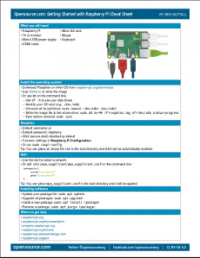Pandoc Cheat Sheet. Created on: 2019-01-21. A quick reference to Pandoc. Created on: 2019-01-20. Using Pencil Project as GUI prototyping tool. PostgreSQL Cheat Sheet. Created on: 2019-01-22. A quick reference to PostgreSQL. Publish Sphinx doc with GitHub Pages.
- USAGE
- Setting document-specific options
- EXTRAS
- EXAMPLE
- Extended example using post-processing options
pdoc - typeset pandoc documents with document-specific, default options
Read and Write to CSV. pd.readcsv('file.csv', header=None, nrows=5). Pandoc supports lua and python based filters to aid in formatting of the documents. For example: pandoc-citeproc parses the citations included in markdown files, pandoc-crossref allows numbering and cross-referencing of figures, tables and equations across the document.
version 0.10.0
This is just a small executable and a hack to pandoc: you can use it to set document-specific, default options for pandoc in the typesetting process. Of course, you can safely ignore these settings and return to the standard way of doing things at all times.
Usage is absolutely straight-forward:
Usage on the commandline
Pandoc Cheat Sheet Template
If you want your file to be typeset using the document-specific default options, run
If you want standard processing of that file, simply run pandoc as usual:
Setting document-specific options
Setting options
Sprinkle <!--+ --pandoc-option1 --pandoc--option2 +--> all over your pandoc file -- just as your would use them on the shell. pdoc will read these and add them to the commandline that is passed to a standard pandoc typesetting.
Defining post-processing behavior
Use <!--& (some post processing action) &--> as the special markup to pdoc for post-processing options. These will be concatenated to the pandoc-commandline that is generated via &&, just like so:
This is just a simple hack reading out specially marked comments in your pandoc source. Everything will stay usable as always. When typesetting in the standard manner, these comments are simply ignored.
See the executable for the details.
Shell variables
You can use shell variables as usual, e.g. $HOME, etc.
Use policies
When doing more complicatd things (see example below) I like to use so-called pandoc-policies (as I call them).
I keep a folder ~/.pandoc/policies next to ~/.pandoc/templates containing files like ~/.pandoc/policies/columns.latex (handling column-layouts) ~/.pandoc/policies/squeeze.latex (for whitespace squeezing), and so on...

All of these policies are to be included by pandoc's -H / --include-in-header=-switch, so it makes:
Suppose you have a squeeze and a columns-policy in your policy-folder, your document might look like this:
Extended example using post-processing options
Pandoc Cheat Sheet Free
Here is a somewhat more complicated example: the cheat-sheet generator that I'm currently using while learning for my final examination:
This cheat-sheet generator can simply be called using pdoc cheatsheet.pandoc and will additionally use pdfjam to squeeze even more of the resulting pdf pages together. On a Mac, it will additionally open the file after the final pdfjam rendering for quality inspection ;-).
Things to note
Note how several policies are grouped together on shell level, using curly-bracket expansion:

Also note, how additional options are set via
pandoc's-V-switch, and how even more options are smuggled in intopandoc's own latex template. (The latter you can find usingpandoc -D latex) in using
pandoc: http://johnmacfarlane.net/pandoc/
pdfjam: http://go.warwick.ac.uk/pdfjam
DBR <dbr@cpan.org>
This software is Copyright (c) 2012 by DBR.
This is free software, licensed under:
To install App::PDoc, copy and paste the appropriate command in to your terminal.
For more information on module installation, please visit the detailed CPAN module installation guide.
